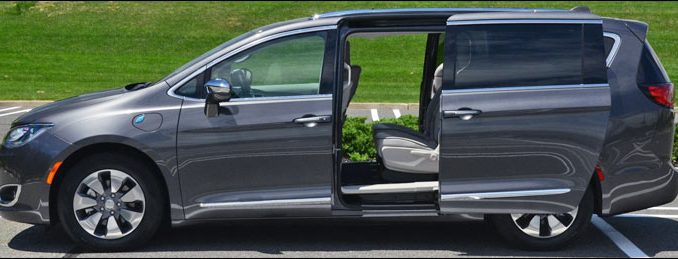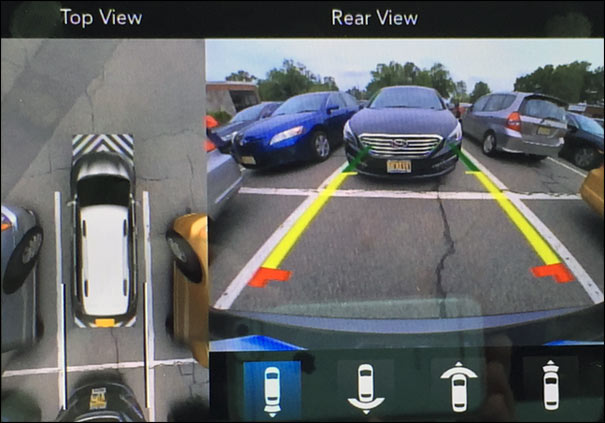
Yesterday, we started a series of articles on the Chrysler Pacifica — the world’s first hybrid-electric minivan, from the makers of the world’s first all-electric minivan.
You may wonder how having enough batteries to push a minivan for 34 miles, or to accelerate from 0-70 without using any gasoline, would affect handling. I would normally assume the Pacifica would ride and handle like a Ram 3500 — the one with leaf-springs in back. I was wrong, because of where the weight is, and because the engineers were working wonders with an already handling-oriented suspension architecture.

Keeping the batteries below the seats actually helps with cornering and feel, by dropping the center of gravity; I drove a hybrid and a regular Pacifica at the Chelsea hairpin-curve course, and the Hybrid handled better and felt more confident around turns despite its extra weight. I found that the big van felt confident and stayed glued to the road over bumpy concrete surfaces.
There was a downside of the extra weight, though; the road feel came through more than you’d expect for a “luxury van,” and while the evils of bump-boing-boing were not present, you do feel potholes, concrete roads, and speed bumps. Overall, the ride is still on the pleasant/cushioned side of comfort rather than the heavy sport, but think Charger R/T vs Chrysler 300.

The brakes worked well, and since much of the braking is handled by the electric motor converting motion into electricity, it’ll be hard to make brake fade into a serious problem. Generally, driving the Pacifica Hybrid was easy and pleasant, with mildly tight steering, and a subtle lane-wander system that’s easy to shut off.
Active noise cancellation essentially eliminates any wind noise, and also kills off loud vehicles next to you (surprisingly well), but doesn’t seem to attack tire drone, including when you go over concrete highways. Regardless, the Pacifica is quieter than pretty much anything else in this price range. That allows for greater enjoyment of the optional stereo, which had good clear sound; the subwoofer is tuned without overemphasized bass — the bass can be clear and strong but not overwhelming.
Self-parking
The best option for parking a minivan, in my opinion, is the 360° camera view. You can set it as one of the “favorite” buttons on the 8.4 inch screen, if you ordered it with the van, and then park as you normally would — but now you can use the front camera as well as the rear camera to see exactly how much space you have left. Yes, you can use that very last inch!
The car has automatic systems that can hit the brakes before you hit the car in front or behind, but I find the cameras less anxiety-provoking. The overhead view also helps if you’re trying to figure out how much room you have on the side, or whether you’re about to scrape a bush.

For those who really don’t want to park, there is the self-parking feature, debuted in the Cherokee, which operates for both parallel parking and perpendicular (pull-in). The first time I encountered this, on a Lexus — the first self-parking feature ever — it was incredibly unusable. You needed two lanes for backing in, and at least two spaces to get into, and the ground had to be perfectly level, and if you used the gas or brake, it shut off. This one is far better; it parallel parked better than I can, getting right up to a half-inch from the curb, and it did it quickly.
The perpendicular parking was more exciting, since I was pretty close to the lineup of cars the first time, and when it had me back up, I got awfully close to planting a bumper into the door of one of the parked cars. The system told me to stop, and perhaps if I’d gotten closer it would have done it for me, but I’m not taking those chances with other people’s cars. I pulled forward, following the system’s guidance, and it straightened out; then I went back. It was an odd experience, with the system spinning the wheel this way and then that way several times, getting it just right. In the end, at the cost of some tire rubber, I was absolutely perfectly parked directly between two other cars. I could get used to this, I think, but if I owned one of these… I’d probably just use the 360° camera. Your experience may vary!
Next article: Seats, storage, and stuff

David Zatz has been writing about cars and trucks since the early 1990s, including books on the Dodge Viper, classic Jeeps, and Chrysler minivans. He also writes on organizational development and business at toolpack.com and covers Mac statistics software at macstats.org. David has been quoted by the New York Times, the Daily Telegraph, the Detroit News, and USA Today.

Leave a Reply